Contemporary Church History Quarterly
Volume 26, Number 3 (September 2020)
Review of Lucia Scherzberg, Zwischen Partei und Kirche: Nationalsozialistische Priester in Österreich und Deutschland (1938-1944), Schriftreihe “Religion und Moderne” Band 20 (Frankfurt am Main: Campus Verlag, 2020). 645 pages, 49,00,- €, (44,99,- € E-Book), ISBN: 9783593444185.
By Kevin P. Spicer, Stonehill College
This review was originally published in theologie.geschichte and is reproduced here with the kind permission of the publisher. The original review is available here: http://universaar.uni-saarland.de/journals/index.php/tg/article/view/1154/1211.
In Zwischen Partei und Kirche, Lucia Scherzberg, professor of systematic theology at Saarland University and co-editor of Theologie.Geschichte, studies a relatively small group of Catholic priests and select laity from Germany and Austria who actively promoted a positive relationship between the National Socialist state and the Catholic Church. In the book’s introduction, among many questions, she asks, “Were they a few crazy fanatics? Were the members isolated or did they find their support in the rest of the clergy?” and “How much did the priests differ in their convictions and actions from the rest of the leadership of the Catholic Church?” (14). Scherzberg finds that though they were fanatical in their support for National Socialism, these Catholic clerics and laity were far from deranged. Rather, they were intelligent, intensely calculating, and fully cognizant of their actions in support of Hitler and the Nazi government and party. Yet, as Scherzberg reveals, at times, their outlook was not always exceptional when compared with some of their fellow clergymen. Still, they made the ill-advised mistake of imperiously bucking the Church’s hierarchical system by assuming roles and tasks traditionally reserved for the Church’s episcopate, and thereby became persona non grata in their dioceses.
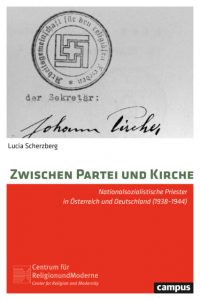 As I have shown in Hitler’s Priests: Catholic Clergy and National Socialism, there were approximately one-hundred-fifty “brown priests” who publicly supported and aligned themselves with National Socialism.[1] In my more broadly based work, I devoted a chapter to examining the National Socialist Priests’ Group (NS-Priests) studied by Scherzberg. By contrast, Scherzberg spent years researching the NS-Priests’ personalities, tracking down minute details, and uncovering extensive networks between and among them. Her research deepens our knowledge of the complexity of church-state relations under National Socialism and builds upon previous works such as Hitler’s Priests. Additionally, the pioneering studies of the late contemporary witness Franz Loidl, professor of church history at the Catholic-Theological Faculty of the University of Vienna, provided Scherzberg with a basic introduction to the NS-Priests that included vital primary documents, though the study was limited in scope and often apologetic in analysis.[2] Josef Lettl’s brief but impressive Diplomarbeit (Master’s Thesis), Arbeitsgemeinschaft für den religösion Frieden 1938 (Association for Religious Peace 1938), offered a general introduction to the initial but short-lived public organization of the NS-Priests.[3] More recently, in Hitlers Jünger und Gottes Hirten (Hitler’s Disciples and God’s Shepherds), Eva Maria Kaiser examined a few of the leading NS-Priests in her study of the Austrian bishops’ post-war advocacy for former National Socialists.[4] In the end, Scherzberg’s study is authoritative and will become a standard work.
As I have shown in Hitler’s Priests: Catholic Clergy and National Socialism, there were approximately one-hundred-fifty “brown priests” who publicly supported and aligned themselves with National Socialism.[1] In my more broadly based work, I devoted a chapter to examining the National Socialist Priests’ Group (NS-Priests) studied by Scherzberg. By contrast, Scherzberg spent years researching the NS-Priests’ personalities, tracking down minute details, and uncovering extensive networks between and among them. Her research deepens our knowledge of the complexity of church-state relations under National Socialism and builds upon previous works such as Hitler’s Priests. Additionally, the pioneering studies of the late contemporary witness Franz Loidl, professor of church history at the Catholic-Theological Faculty of the University of Vienna, provided Scherzberg with a basic introduction to the NS-Priests that included vital primary documents, though the study was limited in scope and often apologetic in analysis.[2] Josef Lettl’s brief but impressive Diplomarbeit (Master’s Thesis), Arbeitsgemeinschaft für den religösion Frieden 1938 (Association for Religious Peace 1938), offered a general introduction to the initial but short-lived public organization of the NS-Priests.[3] More recently, in Hitlers Jünger und Gottes Hirten (Hitler’s Disciples and God’s Shepherds), Eva Maria Kaiser examined a few of the leading NS-Priests in her study of the Austrian bishops’ post-war advocacy for former National Socialists.[4] In the end, Scherzberg’s study is authoritative and will become a standard work.
Scherzberg uses the 1938 Anschluss to divide her work into two parts that contain headings but without chapter numbers. In the first part, Scherzberg identifies the original members of the Arbeitsgemeinschaft für den religiösen Frieden (AGF), the initial rendering of the NS-Priests that became public after the March 1938 Anschluss. The AGF consisted of both lay and ordained Catholics, primarily under the leadership of three individuals: Johann Pircher, a former religious of the Deutsch-Orden who had incardinated into the Vienna archdiocese in 1921 and joined the NSDAP in 1933; Wilhelm van den Bergh, a former Capuchin friar from the Netherlands who like Pircher had incardinated into the Vienna archdiocese in 1929; and Karl Pischtiak, a lay Catholic, National Socialist, and SA-Sturmbannführer who had ties with Josef Bürckel, Reichskommissar für die Wiedervereinigung Österreichs mit dem Reich (Reich Commissioner for the Reunification of Austria with the Reich;1938-1939) and Reichsstatthalter and Gauleiter of Vienna (Reich Governor and NSDAP District Leader; 1939-1940). According to Scherzberg, the AGF developed from the remnants of several Catholic pro-Anschluss groups. The same individuals had also been entangled in more politically aligned extreme right-wing associations such as the Katholisch-Nationalen (Catholic Nationals), the Deutsche Klub (German Club), and the Deutsche Gemeinschaft (German Community). Many of these same individuals had likewise been involved in the post-war Catholic youth movement, which had been heavily influenced by the writings of theologian Michael Pfliegler. Pfliegler criticized political Catholicism and emphasized the importance of the Church’s pastoral mission, especially to promote peace between church and state. Youth associations such as Reichsbund Jungösterreich, Bund Neuland, and Quickborn rejected the Peace Treaty of St. Germain-en-Laye (1919), supported a Greater-Deutschland, and embraced various forms of antisemitism, though generally not racial. Many of their members also rejected the Austrian Corporative State, especially the close alignment between the Austrian Catholic Church and the Dollfuß and Schuschnigg governments. Catholic priests from Styria, whose borders had been affected by the 1919 treaty, particularly rejected the situation of post-war Austria. Scherzberg provides a comprehensive overview of Austria’s pre-Anschluss history to contextualize the AGF’s foundation.
Before the 10 April 1938 National Referendum on the Anschluss, the Austrian bishops issued a solemn declaration that expressed their goodwill towards National Socialism. The Holy See, however, was not pleased by the stance of the Austrian episcopate, especially after the encyclical Mit brennender Sorge (With Deep Anxiety), that criticized the German state’s encroachment on the rights of the Catholic Church. On 8 April 1938, Schmerzensfreitag (Friday of Sorrows), many of the individuals who were predisposed to form the AGF, issued a letter directed to Cardinal Theodor Innitzer, archbishop of Vienna, in support of the Anschluss and critical of the Vatican. Eight days later, on 17 April, Pircher, van den Bergh, and two other priests in the name of the AGF issued a public appeal to the Catholic clergy to support the political developments between Austria and the German Reich. Newspapers covered it and reported that the appeal allegedly resonated with the clergy. Immediately, Jakob Weinbacher, Innitzer’s secretary, made it known that he did not approve. As early as May 1938, the Vienna Diözesanblatt (Diocesan Gazette) reminded clergy that they were not to be involved in politics and should limit their realm of activity to the pastoral sphere. On 30 September 1930, Cardinal Innitzer ordered diocesan newspapers to announce a ban against the AGF. Pircher and van den Bergh were never personally informed beforehand. In October 1938, Pircher issued a statement carried by Austrian newspapers that announced the disbandment of the AGF.
Scherzberg’s argument reveals that the prohibition was not due solely to a question of tactics or a difference of opinion about applying them that led to the AGF’s ban. Instead, one could attribute it more to the nature and function of the diocesan hierarchical structure, whereby only a bishop or his delegate speaks in the name of the Church. The ban also took place during a period of tense church-state conflict as the two sides negotiated for power in annexed Austria. With pressure on his back from the Holy See to assert the rights of the Church and to critique National Socialism, Innitzer could not allow a renegade group of priests to speak for his diocese. Pircher and van den Bergh were not alone. Pircher claimed that 525 priests were members, and an additional 1844 expressed their support (out of 8,000 priests in Austria). Scherzberg finds that these numbers may not be entirely overstated. Through meticulous research, she identifies at least 150 priests who joined the AGF and offers convincing arguments about the missing individuals not accounted for.
Around the time of the AGF’s prohibition, a power struggle ensued between Pircher and Pischtiak. Scherzberg speculates that Pischtiak used his connections with Bürckel to have the Gestapo confiscate the AGF’s membership index from its headquarters in Pircher’s home. At this point, it might have been helpful if Scherzberg had also analyzed the contemporary lay-cleric dynamics in this power struggle. Nevertheless, in the end, Scherzberg reveals that Pircher proved more skillful at power-play, apparently enjoying a more significant share of Bürckel’s trust. Pitschtiak then separated himself from the AGF and disappeared from the historical record.
Even though the AGF had formally disbanded, Pircher refused to let go of his dream to create a mass organization for priests within the NSDAP structure. Moving underground, Pircher maintained his contacts with like-minded priests. In a November 1938 letter to a former AGF member, he declared that the NS-Priests needed to retain, “‘reconciling, mediating, and state-affirming ideas [until] a modus vivendi can be achieved in religious terms’” (228). He was not alone. Pfarrer, Richard Hermann Bühler, a retired priest of the Limburg diocese, suggested that they establish an NS Religionsdiener-Verband (National Socialist Religious Servants Association) that would educate the clergy in a National Socialist spirit. Yet, in the disbanded AGF world, these efforts had little practical impact as the actual group of priests dwindled over time to a select few.
Amid this post-AGF climate, in December 1938, Pircher travelled to Cologne to meet for the first time Richard Kleine, a priest of the Hildesheim diocese and religion teacher at the Duderstadt Gymnasium. Though the specific origins of their initial contact are unknown, Kleine would become a leading figure among the NS-Priests as well as its primary theorist. Kleine’s entry along with others would also broaden the group’s geographic scope, enlarging it from its primarily Austrian locale to a broader demographic reach that would encompass the Greater German Reich.
Scherzberg’s research reveals a great deal more about Kleine than previous studies uncovered. To avoid scandal over Kleine’s illegitimate birth, he had to be ordained for Hildesheim instead of his home diocese of Cologne. Likewise, he was rejected as a Feldgeistlicher (military chaplain) in the First World War. While not overemphasizing these points, Scherzberg speculates that they had an impact on his self-perception and world outlook. Still, Kleine had further influences. His professor, Arnold Rademacher, a specialist in fundamental theology at the University of Bonn, advocated for both church reform and the reunification in faith among the Christian denominations. In the same vein, at University of Tübingen, Wilhelm Koch, professor of dogmatics and apologetics and a progressive intellectual, provided Kleine with a religious worldview that contrasted with the dominant neo-scholastic approach of his era. Accused of the heresy of modernism, Koch ended up leaving teaching and returned to full-time pastoral ministry. The impact of Rademacher and Koch on Kleine would especially be felt when Kleine raised issues that preoccupied him and shared them with members of the NS-Priests.
In addition to Pircher, Kleine, van den Bergh, and Bühler, other prominent members included Alois Nikolussi, a priest of the Trient diocese who in 1919 became a Chorherr of St. Augustine at Stift Sankt Florian; Simon Pirchegger, a priest of the Graz-Seckau diocese, a Dozent of Slavic Studies at University of Bonn, and an NSDAP member; Joseph Mayer, an Augsburg priest and professor of moral theology at Theologische Fakultät Paderborn; and Adolf Herte, a Paderborn priest and a professor of church history and patristics also at Paderborn. As Scherzberg’s previous works have also shown, Karl Adam, professor of systematic theology at the University of Tübingen, later joined this group.[5] A few Catholic laymen were also involved, including Josef Bagus, editor of the Kolpingsblatt, and Alois Brücker, an editor and NSDAP member living in Cologne. For each of these individuals, Scherzberg provides extensive background information to contextualize their support of National Socialism and initial contact with Pircher and Kleine. Additionally, she concludes the first part of her study by discussing the theological positioning of the group. The individual egos of the group’s members, along with the intermittent commitment of each, did not easily lead to consensus on religious questions. Pircher, for example, remained obsessed and convinced of the group’s ability to influence the outlook of high-ranking National Socialists on the Church. Kleine became fixated on an antisemitic interpretation of Christ’s Sermon on the Mount, interpreting it as a declaration of war on Judaism. Finally, Mayer and Herte appeared reluctant in their involvement, having to be nudged along by Pircher.
Part two of the work focuses on the activities of the NS-Priests, who never agreed on an official name for the group. The outbreak of war for Germany, with its decisive initial victories and subsequent harsh defeats, created a radicalization in the group’s outlook. Scherzberg’s systematic theological expertise is evident throughout her writing, especially in part two, as she analyzes the publications and presentations of the group’s members. Most chilling is the parallel she draws between the NS-Priests’ antisemitism, which led members to advocate the removal of references to Jews in Catholic sacramental rites, and the dormant antisemitism among members of a subcommittee dealing with liturgical reform in the Fulda Bishops’ Conference who discussed and similarly advocated for the removal of Jewish names from the marriage rite. Though the German bishops never agreed upon a revised rite for the sacraments under National Socialism, one did appear in 1948, with the Jewish names discussed above removed.
The ideas of the NS-Priests appeared in Kameradschaftlicher Gedankenaustausch (Comradely Exchange of Ideas; KG), a newsletter that ran inconsistently for twenty-seven issues from September 1939 to January 1945. With the help of a Catholic laywoman, Pircher edited and distributed each issue that typically was four pages in length. Pircher published most articles with pseudonyms. Nevertheless, Scherzberg spends significant time and does crucial detective work identifying the authors of the contributions. The KG’s language was overtly nationalistic and repeatedly implored its readers to serve their fatherland faithfully, especially in wartime. Increasingly in each issue, the KG’s language also became more militant and antisemitic. Alongside the KG, on his own initiative, from 1938-1940, Pircher wrote Information zur kulturpolitischen Lage (Information on the Church-Political Situation), mirroring the SD’s Meldungen aus dem Reich (Reports from the Reich), in which he reported on church issues that he believed would be of interest to the state. He shared the reports with Gauleiter Bürckel, who, it appears, for a brief time financially supported Pircher’s efforts. Despite their actions and National Socialist worldview, Pircher and Kleine had little sympathy for priests who proposed a more radical course for the Church’s clergy, such as abandoning clerical celibacy. Likewise, Pircher revealed his allegiance to Catholicism by including criticisms of the state’s treatment of the Catholic Church in his reports. He confided to Kleine that he might end up in Dachau for his more critical comments. Two separate party proceedings to remove Pircher from the NSDAP were eventually introduced, but neither succeeded.
The efforts of the NS-Priests brought them in contact with like-minded clergy and laity from other Christian denominations, and even in contact with representatives of völkisch non-Christian groups. Kleine pursued unification efforts with the Nationalkirchliche Bewegung Deutsche Christen (National Church Movement of German Christians; DC), and with the Völkisch-Religious Gemeinschaft (Ethnonationalist-Religious Community) nurtured by Ernst Graf von Reventlow from Postdam. Though Kleine at first was taken aback by the involvement of a few former Catholic clergymen in the DC, he soon adjusted and began to work with them. The dialogue that ensued led to a series of meetings where the participants attempted to work out the significant obstacles that existed between them. Scherzberg painstakingly analyses the discussion at these meetings and the individuals involved. Due to numerous factors, nothing of note resulted in the end. However, Kleine did receive an invitation from the Protestant biblical studies professor, Walter Grundmann, to join his Institut für Erforschung und Beseitgung des jüdischen Einflusses auf das deutsche kirchliche Leben (Institute for the Study and Eradication of Jewish Influence on German Church Life), which he accepted. As a result, Kleine’s antisemitism became more radical and even at one point promoted an ecclesiastical solution parallel to the Final Solution of the Jewish Question.
Kleine’s work with the DC led him into contact with the Mecklenburg Landesbishof (state bishop) Walther Schultz, who was sympathetic to Klein’s ecumenical efforts. Kleine also sought a similar collaborator from the Catholic side and believed he had found one in the newly appointed archbishop of Paderborn, Lorenz Jaeger, a former Wehrmachtspfarrer (army chaplain). While a previous biography has been sympathetic to Jaeger’s choices under National Socialism[6], Scherzberg’s findings reveal that while Jaeger was staunchly nationalist and open to listening, in the end, he rejected Kleine’s efforts at a joint Protestant-Catholic Pastoral Letter and refused to sanction Kleine’s understanding of church and ecumenism. Yet, Kleine did succeed in bringing together Schultz and Jaeger to a meeting with him to discuss the pastoral letter. A research commission focusing on Jaeger is ongoing in the Paderborn archdiocese.
As the war turned for the worse for Germany, the NS-Priests became more embittered, and their antisemitism proportionally increased. In their voluminous correspondence, they condemned the 1943 Decalogue Letter, which was critical of the state and adopted by the plenary assembly of the Fulda Bishops’ Conference. Scherzberg concludes that the worsening of the war situation and the party’s dwindling attention and notice given to the NS-Priests led to this escalation. One might also perceive that the radical antisemitism was always present, and that the apocalyptic situation at the end of the war provided the impetus for the priests to express their views more openly and, in turn, attempt to prove their allegiance even more. After the war, most of the known members of the NS-Priests, centered around Pircher and Kleine went through some form of denazification and lost their positions. The lay members, less so. Yet, Scherzberg reveals that none dropped their racist National Socialist views, but instead, merely suppressed them.
In her introduction, Scherzberg offered a theoretical framework that included the sociological theories of (de)-differentiation, (de)-secularization, and (re)-sacralization, to understand and evaluate how the priests interacted with the church and state. She returned to this framework in her conclusion. For Scherzberg, the priests she studied lived in a differentiated and often secularized society, operating within their own independent sub-system. She continued, “They demanded freedom of religion, freedom of the church and freedom of conscience. In their understanding state and church were responsible for separate areas – the state for the welfare of the people, the church for the salvation of souls. Consequently, the members of the group consistantly rejected attacks by the state or the party on the church and the practice of religion” (599-600). Yet, in their own way and according to their values, the priests were traditional, upholding priestly celibacy and religious education. Often, they wanted the best of both worlds, rejecting political Catholicism while still hoping to influence political and social processes. At the same time, they were willing to accept the state’s oversight in areas such as the training of clergy.
Scherzberg also considered how the polycratic nature of the NS-State, especially evident in the leadership of Vienna’s Reichsstatthalter und Gauleiter Josef Bürckel and Baldur von Schirach, affected the NS-Priester. Like many Germans, the NS-Priester did not blame Hitler for the persecution of the Church. Instead, they relegated the responsibility to lower-level National Socialists or more likely than not to clergy themselves for not supporting the party and state. While not identifying state leadership style as polycracy, the NS-Priests attempted to benefit from the regionally differentiated leadership approaches at-large by courting Bürckel and Schirach with varying levels of success. Finally, Scherzberg considered the role that masculinity and comradeship played in the relational milieu that NS-Priests fostered. Most of the NS-Priests, for example, bought into the overtly militaristic language of the time, with some taunting or jeering the hesitancy of fellow priests to act, accusing the latter of a breach in masculinity. The comradely address shared between them and displayed boldly on their newsletter, however, ultimately had little weight as conflict and doubt arose among them. In the end, according to Scherzberg, they appear to be lone agents out for themselves and only brought together by a prevailing ideology. Each seemed willing to sell out the other, if necessary, to become more recognized by National Socialist leadership.
Lucia Scherzberg has produced an excellent study that should be widely read. It significantly helps the reader to understand the dangers of extreme nationalism and the temptation to misshape religion for personal and political gain.
Notes:
[1] Kevin P. Spicer, Hitler’s Priests: Catholic Clergy and National Socialism, DeKalb, IL, 2008; vgl. „Gespaltene Loyalität. ‚Braune Priester‘ im Dritten Reich am Beispiel der Diözese Berlin“, übersetz. Ilse Andrews, Historisches Jahrbuch 122 (2002), S. 287-320.
[2] z.B. Franz Loidl, Religionslehrer Johann Pircher. Sekretär und aktivster Mitarbeiter in der ‚Arbeitgemeinschaft für den religiösen Frieden‘ 1938 (Vienna 1972); ders., Hg., Arbeitgemeinschaft für den religiösen Frieden 1938/1939. Dokumentation, 1. Teil (Vienna 1973); ders., Hg., Arbeitgemeinschaft für den religiösen Frieden 1938/1939. Ergänzungs-Dokumentation, 2. Teil (Vienna 1973).
[3] Lettl was a former student of Rudolf Zinnhobler, professor of church history at the katholische Privatuniversität Linz. Josef Lettl, Die Arbeitsgemeinschaft für den religiösen Frieden 1938, Diplomarbeit (Linz 1981).
[4] Eva Maria Kaiser, Hitlers Jünger und Gottes Hirten: Der Einsatz der katholischen Bischöfe Österreichs für ehemalige Nationalsozialisten nach 1945 (Wien/Köln/Weimar 2017).
[5] Lucia Scherzberg, Kirchenreform mit Hilfe des Nationalsozialismus. Karl Adam als kontextueller Theologe. (Darmstadt 2001) and ders., Karl Adam und der Nationalsozialismus (Saarbrücken 2011; theologie.geschichte, Beiheft 3).
[6] Heribert Gruß, Erzbischof Lorenz Jaeger als Kirchenführer im Dritten Reich. Tatsachen-Dokumente-Entwicklungen-Kontext-Probleme (Paderborn 1995).
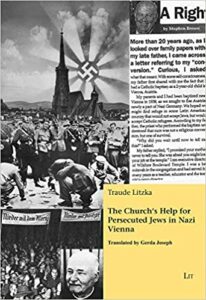 Despite the challenges of locating survivors and documents which would testify to the actions of the brave Catholic men and women engaged in rescue work, Litzka has assembled quite a roster of both individuals as well as orders of religious who decided that, despite the threat of arrest, interrogation, and imprisonment (or worse), their consciences would not allow them to remain inactive in the face of overwhelming discrimination and hardships. One such man who figures prominently throughout the book is the Jesuit priest, Ludger Born (born in Duisburg in 1897). Born was appointed as head of the “Aid Office for Non-Aryan Catholics” by Cardinal Theodor Innitzer in 1940 and for the next five years, Father Born worked assiduously to aid all those who needed help. He inherited his position from another priest, Father Georg Bichlmair, who had established the office and had staffed it primarily with dedicated women. Some of these women’s stories were later documented after the war by Father Born, providing some insight into both their identity and motivations. Out of the twenty-three employees, Father Born’s documentation focused on only five of the female workers. He attributed their dedication to their profound religiosity.
Despite the challenges of locating survivors and documents which would testify to the actions of the brave Catholic men and women engaged in rescue work, Litzka has assembled quite a roster of both individuals as well as orders of religious who decided that, despite the threat of arrest, interrogation, and imprisonment (or worse), their consciences would not allow them to remain inactive in the face of overwhelming discrimination and hardships. One such man who figures prominently throughout the book is the Jesuit priest, Ludger Born (born in Duisburg in 1897). Born was appointed as head of the “Aid Office for Non-Aryan Catholics” by Cardinal Theodor Innitzer in 1940 and for the next five years, Father Born worked assiduously to aid all those who needed help. He inherited his position from another priest, Father Georg Bichlmair, who had established the office and had staffed it primarily with dedicated women. Some of these women’s stories were later documented after the war by Father Born, providing some insight into both their identity and motivations. Out of the twenty-three employees, Father Born’s documentation focused on only five of the female workers. He attributed their dedication to their profound religiosity.
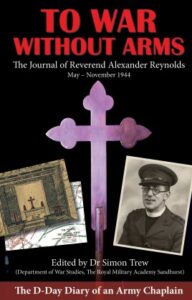 Readers eager to expand their knowledge of World War II will appreciate details that are rarely addressed in standard histories. Reynolds, who served with the 120th Light Anti-Aircraft Regiment, describes how he experienced the elaborate preparations for the Normandy landings, including three days on board LST (Landing Ships Tank) 319. He also provides a fascinating glimpse into British interactions with locals in northern France and Belgium in the months after the breakout. For example, through a funeral he conducted for a Protestant civilian, Reynolds met and befriended a French woman, Mlle Perremond, who spoke excellent English. He subsequently learned that she and two other French women, one young, the other elderly, had helped seven downed RAF pilots escape to England.
Readers eager to expand their knowledge of World War II will appreciate details that are rarely addressed in standard histories. Reynolds, who served with the 120th Light Anti-Aircraft Regiment, describes how he experienced the elaborate preparations for the Normandy landings, including three days on board LST (Landing Ships Tank) 319. He also provides a fascinating glimpse into British interactions with locals in northern France and Belgium in the months after the breakout. For example, through a funeral he conducted for a Protestant civilian, Reynolds met and befriended a French woman, Mlle Perremond, who spoke excellent English. He subsequently learned that she and two other French women, one young, the other elderly, had helped seven downed RAF pilots escape to England. The essays in Blaschke and Großbölting’s volume continue this investigation in a similar vein by widening and deepening it. They ask: Where did the churches and National Socialism interact with each other? In what ways did they stand in each other’s way? How did they compete for members or prominence? And how did they promote each other’s particular concerns? For the editors, an apologetic and mistaken emphasis on resistance – “cross versus sword” narrative – has dominated the interpretative framework of studies on Christianity in Germany under National Socialism. By contrast, however, they view the period fluidly, recognizing that few Germans rejected Nazism entirely. They claim a closer tie between the two than previously articulated in the Gaius and Nolzen collection as well as by others. If one concludes that religion was a significant factor in German society in the 1920s and 30s, they raise the following questions: did National Socialism arise despite Christianity, as many historians have suggested, or did Nazism develop and establish itself precisely because of society’s Christian character? The essays of this volume primarily support the latter by exposing the interplay of National Socialism and Christianity in a variety of historical situations.
The essays in Blaschke and Großbölting’s volume continue this investigation in a similar vein by widening and deepening it. They ask: Where did the churches and National Socialism interact with each other? In what ways did they stand in each other’s way? How did they compete for members or prominence? And how did they promote each other’s particular concerns? For the editors, an apologetic and mistaken emphasis on resistance – “cross versus sword” narrative – has dominated the interpretative framework of studies on Christianity in Germany under National Socialism. By contrast, however, they view the period fluidly, recognizing that few Germans rejected Nazism entirely. They claim a closer tie between the two than previously articulated in the Gaius and Nolzen collection as well as by others. If one concludes that religion was a significant factor in German society in the 1920s and 30s, they raise the following questions: did National Socialism arise despite Christianity, as many historians have suggested, or did Nazism develop and establish itself precisely because of society’s Christian character? The essays of this volume primarily support the latter by exposing the interplay of National Socialism and Christianity in a variety of historical situations.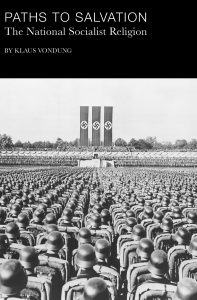 Vondung is clear from the outset that he believes central religious notions such as redemption or salvation have also formed links to very different movements across Germany’s history, from nationalist movements arising out of the Napoleonic Wars through to intellectual movements, and that National Socialism must also be considered ‘a political movement’ with ‘political goals.’ The introduction in itself explores a fascinating and diverse cast of characters, ranging from Fichte to Johst to Mirbt to Gerstenhauer, but argues a kind of coherence around the central theme of a desire for ‘redemption.’ Vondung writes extremely well, and consistently draws on a broad knowledge of German history. His larger historical perspective does sometimes mean that comparisons are drawn from examples that range from the Napoleonic wars to the Nazi state. For readers familiar with the larger history of Germany, this poses no issue, but it does assume an understanding of key historical context. Despite the fact that figures which are quoted come from different periods of time, the central desire for ‘redemption’ is argued to have been born from a ‘complex of motives’ that are summarised as ‘a combination of national frustration, fundamental unease with modernity, and the feeling that life was devoid of meaning.’ While the Introduction does not fully explain the purpose of this book, it does illustrate the overarching approach of many scholars who write in the field of ‘political religion’– that that there is either a perceived inadequacy in religion or an inefficacy of religion to fill the need for meaning in modernity (dominated by ‘rationalism and materialism’) that has led people to seek ‘a new spiritual home.’
Vondung is clear from the outset that he believes central religious notions such as redemption or salvation have also formed links to very different movements across Germany’s history, from nationalist movements arising out of the Napoleonic Wars through to intellectual movements, and that National Socialism must also be considered ‘a political movement’ with ‘political goals.’ The introduction in itself explores a fascinating and diverse cast of characters, ranging from Fichte to Johst to Mirbt to Gerstenhauer, but argues a kind of coherence around the central theme of a desire for ‘redemption.’ Vondung writes extremely well, and consistently draws on a broad knowledge of German history. His larger historical perspective does sometimes mean that comparisons are drawn from examples that range from the Napoleonic wars to the Nazi state. For readers familiar with the larger history of Germany, this poses no issue, but it does assume an understanding of key historical context. Despite the fact that figures which are quoted come from different periods of time, the central desire for ‘redemption’ is argued to have been born from a ‘complex of motives’ that are summarised as ‘a combination of national frustration, fundamental unease with modernity, and the feeling that life was devoid of meaning.’ While the Introduction does not fully explain the purpose of this book, it does illustrate the overarching approach of many scholars who write in the field of ‘political religion’– that that there is either a perceived inadequacy in religion or an inefficacy of religion to fill the need for meaning in modernity (dominated by ‘rationalism and materialism’) that has led people to seek ‘a new spiritual home.’ After the war’s end, Father Fabisiak was working as a missionary in Bolivia. There, many people expressed their curiosity about “the Phenomenon,” or, as we call it, the Holocaust. The Polish priest served as a living witness to the events his parishioners had only heard about over radio broadcasts or had read in newspapers. And many of them were skeptical: could such atrocities have truly been committed by human beings? How could something so obscene as the Holocaust have been possible? This reluctance to accept what had happened inspired Fabisiak to write down his experiences—not out of hatred for the enemy, but as a way of showing readers what human beings are capable of doing to one another. Each chapter is very brief, written like a vignette, allowing readers to move easily from one terrifying experience to the next. All of this was written with the intent of documenting the truth of Father Fabisiak’s fate when he was in the hands of the Nazis.
After the war’s end, Father Fabisiak was working as a missionary in Bolivia. There, many people expressed their curiosity about “the Phenomenon,” or, as we call it, the Holocaust. The Polish priest served as a living witness to the events his parishioners had only heard about over radio broadcasts or had read in newspapers. And many of them were skeptical: could such atrocities have truly been committed by human beings? How could something so obscene as the Holocaust have been possible? This reluctance to accept what had happened inspired Fabisiak to write down his experiences—not out of hatred for the enemy, but as a way of showing readers what human beings are capable of doing to one another. Each chapter is very brief, written like a vignette, allowing readers to move easily from one terrifying experience to the next. All of this was written with the intent of documenting the truth of Father Fabisiak’s fate when he was in the hands of the Nazis. This is not a typical academic monograph. Students or scholars looking for a rigorous critical examination of Reinisch and his environment, with careful documentation of the evidence, will be disappointed. Rice’s judgment of his subject his balanced – he depicts Reinisch as a flawed human whose strength of will was extraordinary but who also clearly had his faults – but his sympathy for Reinisch is tangible. Rice does not provide consistent citations, though occasionally he will clarify a term or refer to a source for a quotation. His “source books”, listed at the end in (seemingly) random rather than alphabetical order, contain relevant scholarship on Reinisch in both English and German, but is not exhaustive on any given subject, indicates no archival research, and includes references whose impact on the text are unclear. For instance, Hans Fallada’s Alone in Berlin, Primo Levi’s If This is a Man, and Heinz Höhne’s The Order of the Death’s Head are all mentioned, but do not appear nor are they alluded to in the main text. What scholars are likely to find most problematic, though, is the style in which Rice chooses to write: in an interview with The Irish Examiner, Rice explains, “I didn’t want it to be a history book. I wanted to write it like a film script, so that you could see things happening. I couldn’t be a fly on the wall, but I tried to get inside the protagonist’s head, and I took on Joyce’s and Proust’s stream of consciousness.”
This is not a typical academic monograph. Students or scholars looking for a rigorous critical examination of Reinisch and his environment, with careful documentation of the evidence, will be disappointed. Rice’s judgment of his subject his balanced – he depicts Reinisch as a flawed human whose strength of will was extraordinary but who also clearly had his faults – but his sympathy for Reinisch is tangible. Rice does not provide consistent citations, though occasionally he will clarify a term or refer to a source for a quotation. His “source books”, listed at the end in (seemingly) random rather than alphabetical order, contain relevant scholarship on Reinisch in both English and German, but is not exhaustive on any given subject, indicates no archival research, and includes references whose impact on the text are unclear. For instance, Hans Fallada’s Alone in Berlin, Primo Levi’s If This is a Man, and Heinz Höhne’s The Order of the Death’s Head are all mentioned, but do not appear nor are they alluded to in the main text. What scholars are likely to find most problematic, though, is the style in which Rice chooses to write: in an interview with The Irish Examiner, Rice explains, “I didn’t want it to be a history book. I wanted to write it like a film script, so that you could see things happening. I couldn’t be a fly on the wall, but I tried to get inside the protagonist’s head, and I took on Joyce’s and Proust’s stream of consciousness.” As I have shown in Hitler’s Priests: Catholic Clergy and National Socialism, there were approximately one-hundred-fifty “brown priests” who publicly supported and aligned themselves with National Socialism.
As I have shown in Hitler’s Priests: Catholic Clergy and National Socialism, there were approximately one-hundred-fifty “brown priests” who publicly supported and aligned themselves with National Socialism.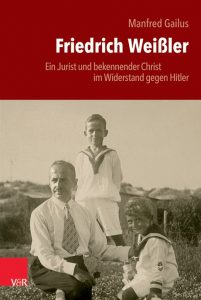 Friedrich Weißler is another such figure. A legal advisor to the Confessing Church, he is usually mentioned (if at all) in his connection to the 1936 Confessing Church memorandum (Denkschrift) to Adolf Hitler. Tortured and beaten to death in Sachsenhausen in February 1937, Weißler was the only person to be killed as a result of the memorandum. Not coincidentally, he was also the only “Volljude” involved. This 2017 book by Manfred Gailus is a gripping biography of a courageous man and a well-documented account of the genesis and aftermath of the memorandum. (Gailus is the first author to examine the papers that were in the family possession.)
Friedrich Weißler is another such figure. A legal advisor to the Confessing Church, he is usually mentioned (if at all) in his connection to the 1936 Confessing Church memorandum (Denkschrift) to Adolf Hitler. Tortured and beaten to death in Sachsenhausen in February 1937, Weißler was the only person to be killed as a result of the memorandum. Not coincidentally, he was also the only “Volljude” involved. This 2017 book by Manfred Gailus is a gripping biography of a courageous man and a well-documented account of the genesis and aftermath of the memorandum. (Gailus is the first author to examine the papers that were in the family possession.) Malick is an atypical American director: he has protected his private life to the point of reclusiveness; his projects routinely consume several years; while he has made several critically-acclaimed films (his first film, Badlands; The Thin Red Line, about the Vietnam War; The Tree of Life, about immortality), he is both lauded and criticized for favouring themes and visual aesthetics over plot and narrative (see The Tree of Life). In fact, A Hidden Life delivers a more linear narrative than many of his films, with an identifiable beginning, middle, and end. It opens with Leni Riefenstahl’s Triumph des Willens, the famous aerial shot of clouds and a city gradually coalescing through the mist. Lasting only the first couple of minutes, and including splices from elsewhere in that famous 1934 documentary, such as the stunning panorama of the Nazi Party’s rally grounds, this is all Malick gives to the audience of Hitler’s climb to power and takeover of Austria and Czechoslovakia before plunging directly into the fall of 1939. Franz Jägerstätter (August Diehl) is married to Franziscka (“Fani”, Valerie Pachner), and has two small blonde-haired, blue-eyed daughters. They live in the Upper Austrian village of Sankt Radegund, not far from the German border (Bavaria). We watch them pause in their labour as unseen planes fly overhead, our only clue that the war has begun.
Malick is an atypical American director: he has protected his private life to the point of reclusiveness; his projects routinely consume several years; while he has made several critically-acclaimed films (his first film, Badlands; The Thin Red Line, about the Vietnam War; The Tree of Life, about immortality), he is both lauded and criticized for favouring themes and visual aesthetics over plot and narrative (see The Tree of Life). In fact, A Hidden Life delivers a more linear narrative than many of his films, with an identifiable beginning, middle, and end. It opens with Leni Riefenstahl’s Triumph des Willens, the famous aerial shot of clouds and a city gradually coalescing through the mist. Lasting only the first couple of minutes, and including splices from elsewhere in that famous 1934 documentary, such as the stunning panorama of the Nazi Party’s rally grounds, this is all Malick gives to the audience of Hitler’s climb to power and takeover of Austria and Czechoslovakia before plunging directly into the fall of 1939. Franz Jägerstätter (August Diehl) is married to Franziscka (“Fani”, Valerie Pachner), and has two small blonde-haired, blue-eyed daughters. They live in the Upper Austrian village of Sankt Radegund, not far from the German border (Bavaria). We watch them pause in their labour as unseen planes fly overhead, our only clue that the war has begun.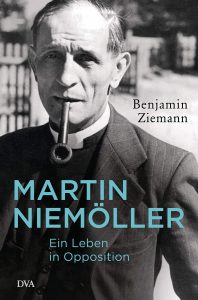 To this day, Martin Niemöller remains one of the most famous German churchmen of the twentieth century. He is regarded as an upright resistance fighter against Hitler, who testified to his stance with seven years of incarceration in concentration camps, as a preacher who admonished German “guilt” and as someone who had transformed from an imperial submarine commander of the First World War into a pacifist, who during the 1950s eloquently and powerfully opposed the Federal Republic of Germany’s Western alliance, its remilitarization, and nuclear weapons. Now, 35 years after Niemöller’s death in 1984, Benjamin Ziemann, Professor of Modern German History at the University of Sheffield and Fellow of the Royal Historical Society, cuts through the thicket of legend concerning Niemöller’s story and uncovers important strands of his life.
To this day, Martin Niemöller remains one of the most famous German churchmen of the twentieth century. He is regarded as an upright resistance fighter against Hitler, who testified to his stance with seven years of incarceration in concentration camps, as a preacher who admonished German “guilt” and as someone who had transformed from an imperial submarine commander of the First World War into a pacifist, who during the 1950s eloquently and powerfully opposed the Federal Republic of Germany’s Western alliance, its remilitarization, and nuclear weapons. Now, 35 years after Niemöller’s death in 1984, Benjamin Ziemann, Professor of Modern German History at the University of Sheffield and Fellow of the Royal Historical Society, cuts through the thicket of legend concerning Niemöller’s story and uncovers important strands of his life. This book, edited by Alf Christophersen and Benjamin Ziemann, has given a surprising moment in Niemöller’s life its most thorough explication. It also offers readers an edited version of the handwritten manuscript Niemöller produced within a period of less than three months during his four years of solitary confinement in Sachsenhausen. His assessment of Catholicism versus Protestantism, a document which numbers over 200 pages in Niemöller’s hand, now comprises 150 printed pages in this book.
This book, edited by Alf Christophersen and Benjamin Ziemann, has given a surprising moment in Niemöller’s life its most thorough explication. It also offers readers an edited version of the handwritten manuscript Niemöller produced within a period of less than three months during his four years of solitary confinement in Sachsenhausen. His assessment of Catholicism versus Protestantism, a document which numbers over 200 pages in Niemöller’s hand, now comprises 150 printed pages in this book.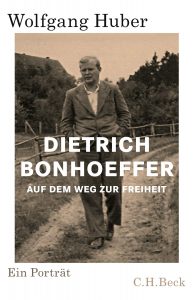 The structure of the book is not unduly distinctive, but it sets out clearly the overall argument and method. Huber’s Bonhoeffer is certainly a big and complex figure. He is also one full of contrasts and the author delights in framing and exploring them. An introductory section evokes the figure of Bonhoeffer as we might first encounter him in a variety of places, not least over the Great West Door of Westminster Abbey. There follows a section on Bonhoeffer’s background and early formation and then another three on his early work in the contexts of university and church life, the first situating him firmly in the landscapes of German thought, the second examining a theology of grace which was deeply rooted in the precepts of Lutheranism, and the third discussing the place of the Bible in a world of maturing historical criticism. Each of these sections present dualities which already defined so much in Bonhoeffer’s work (‘Individual spirituality or Society’; ‘The Church of the World or the Church of the Word’; ‘Acting justly and waiting for God’s own time’; ‘The Historical Jesus or the Jesus of Today’). The young Bonhoeffer is certainly very much at home in the intellectual landscapes of German Lutheranism but the emerging vision is an open one and there is no knowing where it will lead.
The structure of the book is not unduly distinctive, but it sets out clearly the overall argument and method. Huber’s Bonhoeffer is certainly a big and complex figure. He is also one full of contrasts and the author delights in framing and exploring them. An introductory section evokes the figure of Bonhoeffer as we might first encounter him in a variety of places, not least over the Great West Door of Westminster Abbey. There follows a section on Bonhoeffer’s background and early formation and then another three on his early work in the contexts of university and church life, the first situating him firmly in the landscapes of German thought, the second examining a theology of grace which was deeply rooted in the precepts of Lutheranism, and the third discussing the place of the Bible in a world of maturing historical criticism. Each of these sections present dualities which already defined so much in Bonhoeffer’s work (‘Individual spirituality or Society’; ‘The Church of the World or the Church of the Word’; ‘Acting justly and waiting for God’s own time’; ‘The Historical Jesus or the Jesus of Today’). The young Bonhoeffer is certainly very much at home in the intellectual landscapes of German Lutheranism but the emerging vision is an open one and there is no knowing where it will lead. Rebecca Scherf’s study of the German Evangelical Church’s (GEC) responses to the concentration camps is a significant new contribution to the scholarship. While her main focus concerns Protestant clergy who were sent to concentration camps (she confined her study to concentration camps, so it does not include pastors who were in prisons), she has broadened her analysis to address three points of intersection between the GEC and the concentration camp system. The first concerns the relationship between regional churches and the Protestant chaplains who served in the early camps. The second examines the official church responses when clergy were sent to camps. The third looks at the experiences of those who were imprisoned in camps by drawing on contemporary documentation and subsequent memoirs. There are several appendixes with helpful graphs illustrating the number of clergy arrests by year (1935—when there were mass arrests of Confessing pastors due to a pulpit protest—was the peak), by camp, and by regional church. While most clergy who were sent to camps were held only briefly (indicating that the Nazi state intended such arrests as a form of intimidation), the number of arrests during the war grew and fewer were released. There is also a chronologically and geographically organized list of the Protestant clergy who were imprisoned.
Rebecca Scherf’s study of the German Evangelical Church’s (GEC) responses to the concentration camps is a significant new contribution to the scholarship. While her main focus concerns Protestant clergy who were sent to concentration camps (she confined her study to concentration camps, so it does not include pastors who were in prisons), she has broadened her analysis to address three points of intersection between the GEC and the concentration camp system. The first concerns the relationship between regional churches and the Protestant chaplains who served in the early camps. The second examines the official church responses when clergy were sent to camps. The third looks at the experiences of those who were imprisoned in camps by drawing on contemporary documentation and subsequent memoirs. There are several appendixes with helpful graphs illustrating the number of clergy arrests by year (1935—when there were mass arrests of Confessing pastors due to a pulpit protest—was the peak), by camp, and by regional church. While most clergy who were sent to camps were held only briefly (indicating that the Nazi state intended such arrests as a form of intimidation), the number of arrests during the war grew and fewer were released. There is also a chronologically and geographically organized list of the Protestant clergy who were imprisoned.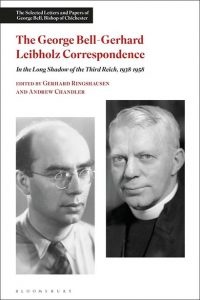 The volume opens with Bell’s September 1938 letter to Bonhoeffer assuring him of his willingness to help the Leibholzes. George Bell had been actively involved since 1933 in assisting refugees from Nazi Germany, including members of the Confessing Church who were affected by the Nazi laws. The early correspondence offers a detailed picture of the difficulties refugees faced even after they reached a safe country. They could not assume, of course, that they would remain in safety; Leibholz’s brother Hans and his wife managed to reach Holland, but committed suicide in 1940 after the German invasion. Added to this anxiety were financial concerns (Germany froze Leibholz’s assets when he fled, so they arrived in England with nothing), worries about the family they had left behind, existential concerns about employment and the future, and dealing with anti-German prejudice in England once the war began. In May 1940 Leibholz was interned as an “enemy alien” on the Isle of Man, along with a number of Confessing Church pastors and their wives. Bell managed to obtain his release in August 1940, after which the two men pursued the possibility that the Leibholzes might immigrate to the United States. With the assistance of Dietrich Bonhoeffer’s contacts in New York, Leibholz was offered and accepted an invitation to Union Theological Seminary in 1941, but by then the door had closed due to new U.S. restrictions on immigration.
The volume opens with Bell’s September 1938 letter to Bonhoeffer assuring him of his willingness to help the Leibholzes. George Bell had been actively involved since 1933 in assisting refugees from Nazi Germany, including members of the Confessing Church who were affected by the Nazi laws. The early correspondence offers a detailed picture of the difficulties refugees faced even after they reached a safe country. They could not assume, of course, that they would remain in safety; Leibholz’s brother Hans and his wife managed to reach Holland, but committed suicide in 1940 after the German invasion. Added to this anxiety were financial concerns (Germany froze Leibholz’s assets when he fled, so they arrived in England with nothing), worries about the family they had left behind, existential concerns about employment and the future, and dealing with anti-German prejudice in England once the war began. In May 1940 Leibholz was interned as an “enemy alien” on the Isle of Man, along with a number of Confessing Church pastors and their wives. Bell managed to obtain his release in August 1940, after which the two men pursued the possibility that the Leibholzes might immigrate to the United States. With the assistance of Dietrich Bonhoeffer’s contacts in New York, Leibholz was offered and accepted an invitation to Union Theological Seminary in 1941, but by then the door had closed due to new U.S. restrictions on immigration.